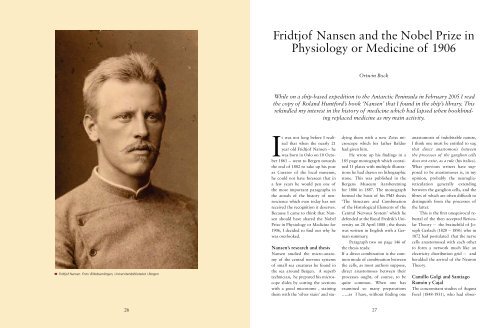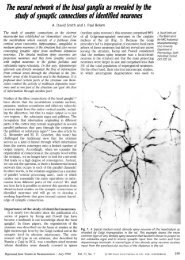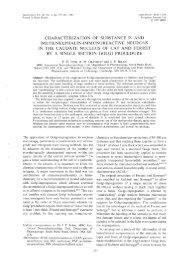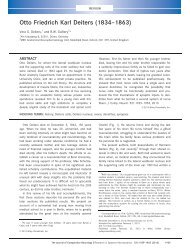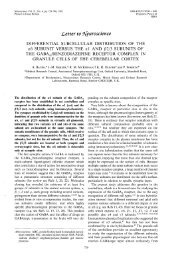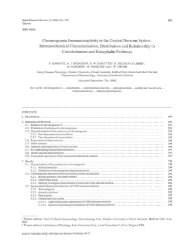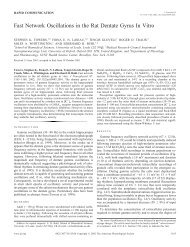Fridtjof Nansen og Nobelprisen i medisin i 1906
Fridtjof Nansen og Nobelprisen i medisin i 1906
Fridtjof Nansen og Nobelprisen i medisin i 1906
You also want an ePaper? Increase the reach of your titles
YUMPU automatically turns print PDFs into web optimized ePapers that Google loves.
<strong>Fridtjof</strong> <strong>Nansen</strong>. Foto: Billedsamlingen, Universitetsbiblioteket i Bergen<br />
<strong>Fridtjof</strong> <strong>Nansen</strong> and the Nobel Prize in<br />
Physiol<strong>og</strong>y or Medicine of <strong>1906</strong><br />
It was not long before I realized<br />
that when the nearly 21<br />
year old <strong>Fridtjof</strong> <strong>Nansen</strong> – he<br />
was born in Oslo on 10 October<br />
1861 -- went to Bergen towards<br />
the end of 1882 to take up his post<br />
as Curator of the local museum,<br />
he could not have foreseen that in<br />
a few years he would pen one of<br />
the most important paragraphs in<br />
the annals of the history of neuroscience<br />
which even today has not<br />
received the rec<strong>og</strong>nition it deserves.<br />
Because I came to think that <strong>Nansen</strong><br />
should have shared the Nobel<br />
Prize in Physiol<strong>og</strong>y or Medicine for<br />
<strong>1906</strong>, I decided to find out why he<br />
was overlooked.<br />
<strong>Nansen</strong>’s research and thesis<br />
<strong>Nansen</strong> studied the micro-anatomy<br />
of the central nervous systems<br />
of small sea creatures he found in<br />
the sea around Bergen. A superb<br />
technician, he prepared his microscope<br />
slides by cutting the sections<br />
with a good microtome , staining<br />
them with the ‘silver stain’ and stu-<br />
Ortwin Bock<br />
While on a ship-based expedition to the Antarctic Peninsula in February 2005 I read<br />
the copy of Roland Huntford’s book ‘<strong>Nansen</strong>’ that I found in the ship’s library. This<br />
rekindled my interest in the history of medicine which had lapsed when bookbinding<br />
replaced medicine as my main activity.<br />
dying them with a new Zeiss microscope<br />
which his father Baldur<br />
had given him.<br />
He wrote up his findings in a<br />
185 page mon<strong>og</strong>raph which contained<br />
11 plates with multiple illustrations<br />
he had drawn on lith<strong>og</strong>raphic<br />
stone. This was published in the<br />
Bergens Museum Aarsberetning<br />
for 1886 in 1887. The mon<strong>og</strong>raph<br />
formed the basis of his PhD thesis<br />
‘The Structure and Combination<br />
of the Histol<strong>og</strong>ical Elements of the<br />
Central Nervous System’ which he<br />
defended at the Royal Fredrik’s University<br />
on 28 April 1888 ; the thesis<br />
was written in English with a German<br />
summary.<br />
Paragraph two on page 146 of<br />
the thesis reads:<br />
If a direct combination is the common<br />
mode of combination between<br />
the cells, as most authors suppose,<br />
direct anastomoses between their<br />
processes ought, of course, to be<br />
quite common. When one has<br />
examined so many preparations<br />
…..as I have, without finding one<br />
26<br />
27<br />
anastomosis of indubitable nature,<br />
I think one must be entitled to say,<br />
that direct anastomosis between<br />
the processes of the ganglion cells<br />
does not exist, as a rule (his italics).<br />
What previous writers have supposed<br />
to be anastomoses is, in my<br />
opinion, probably the neur<strong>og</strong>liareticulation<br />
generally extending<br />
between the ganglion cells, and the<br />
fibres of which are often difficult to<br />
distinguish from the processes of<br />
the latter.<br />
This is the first unequivocal rebuttal<br />
of the then accepted Reticular<br />
Theory -- the brainchild of Joseph<br />
Gerlach (1820 – 1896) who in<br />
1872 had postulated that the nerve<br />
cells anastomosed with each other<br />
to form a network much like an<br />
electricity distribution grid -- and<br />
heralded the arrival of the Neuron<br />
Theory.<br />
Camillo Golgi and Santiago<br />
Ramón y Cajal<br />
The concomitant studies of August<br />
Forel (1848-1931), who had obser-
ved that degeneration in the nervous<br />
system did not spread but was<br />
confined to the limits of the cell,<br />
and Wilhelm His Sr (1831 – 1904),<br />
who had discovered that in human<br />
embryos during the early stages of<br />
development the nerve cells were<br />
not in contact with one another,<br />
was further proof that the Reticular<br />
Theory was wrong. But it was the<br />
studies of Santiago Ramón y Cajal<br />
(1852 – 1934) which proved beyond<br />
doubt that the central nervous system<br />
in animals and humans is made<br />
up of innumerable neurons (the<br />
word was coined by Wilhelm Waldeyer<br />
(1836 – 1921) in 1891) which<br />
are anatomically independent of<br />
one another, the Neuron Theory or<br />
Neuron Doctrine.<br />
Like <strong>Nansen</strong>, Cajal also relied<br />
heavily on the silver stain – ‘the<br />
black reaction’— which Camillo<br />
Golgi (1836 – 1921) had developed<br />
in 1873, and in <strong>1906</strong> he and Golgi<br />
shared the Nobel Prize in Physiol<strong>og</strong>y<br />
or Medicine. Cajal, an ebullient<br />
and self-promoting personality who<br />
only entered the field in 1887 when<br />
Luis Simarro (1851 – 1921) showed<br />
him microscope slides of central<br />
nervous system tissue prepared with<br />
the silver stain, would become a dominant<br />
figure in the world of neuroscience<br />
through his attendance<br />
at international congresses and his<br />
many authoritative textbooks and<br />
scientific publications. The more<br />
retiring Golgi on the other hand,<br />
who had left the study of the central<br />
nervous system some years before<br />
to concentrate his energies on<br />
his research on malaria, his duties<br />
as Rector of Pavia University and<br />
as a local and national politician,<br />
rather blunted his reputation when<br />
he vigorously defended the Reticular<br />
Theory during his Nobel lecture<br />
-- ‘La doctrine du neurone. Théorie<br />
et faits’-- on 11 December <strong>1906</strong> despite<br />
mounting evidence that the theory<br />
was most probably wrong. He<br />
briefly referred to <strong>Nansen</strong> during<br />
the lecture, but Cajal, who summarized<br />
his 25 years of research in his<br />
lecture -- ‘Structure et Connexions<br />
des Neurones’-- the next day, never<br />
mentioned <strong>Nansen</strong>.<br />
Golgi and Cajal, who met at<br />
Stockholm for the first time, never<br />
became friends. As far as is known,<br />
<strong>Nansen</strong> never met or corresponded<br />
with Cajal who appeared reluctant<br />
to quote him in his textbooks and<br />
does not mention him in his autobi<strong>og</strong>raphy<br />
of 1923. With Golgi, from<br />
whom he had learned the ‘black<br />
reaction’ at first hand in April 1886,<br />
<strong>Nansen</strong> exchanged the occasional<br />
cordial letter and much to his regret<br />
had to turn down Golgi’s invitation<br />
of 6 December 1902 to a meeting to<br />
be held at Turin because of pressing<br />
work at home.<br />
<strong>Nansen</strong> - the forgotten<br />
neuroscientist<br />
<strong>Nansen</strong> never returned to neuroscience<br />
after he set off on his Greenland<br />
expedition a few days after<br />
the public defense of his thesis. He<br />
became known for his glittering<br />
achievements as a polar explorer (it<br />
is hard to imagine the emotions he<br />
must have felt on 11 June 1896 at<br />
Cape Flora on Northbrook Island<br />
in the Franz Josef Land archipelago<br />
when he followed up the barking<br />
of d<strong>og</strong>s and saw Frederick Jackson<br />
(1860-1938) in the distance) and<br />
winner of the Nobel Peace Prize of<br />
1922 in rec<strong>og</strong>nition of his humani-<br />
tarian work in Eastern Europe after<br />
World War 1. Outside Norway and<br />
Sweden only a few people might<br />
have been aware of the prominent<br />
role he played in the dissolution on<br />
7 June 1905 of the unhappy Union<br />
between the two countries, and fewer<br />
still would have known that he<br />
made important contributions to<br />
neuroscience as a young man. His<br />
reputation as a scientist now rested<br />
on his studies of the northern oceans.<br />
The <strong>Nansen</strong> Symposium on<br />
New Concepts in Neuroscience was<br />
a 3-day centenary symposium held<br />
at Bergen in August 1987 to commemorate<br />
<strong>Nansen</strong>’s contribution<br />
to neurobiol<strong>og</strong>y. The proceedings,<br />
which were published in English,<br />
included contributions on various<br />
aspects of <strong>Nansen</strong>’s time in Bergen<br />
and a facsimile reproduction of his<br />
thesis.<br />
In their attempt to remind the<br />
scientific community of <strong>Nansen</strong>’s<br />
achievements as a neuroscientist<br />
the editors later got support from<br />
Edwards and Huntford whose review<br />
article ‘<strong>Fridtjof</strong> <strong>Nansen</strong>: from<br />
the neuron to the North Polar Sea’<br />
appeared in 1998: they credited<br />
<strong>Nansen</strong> with being the first person<br />
to question the credibility of the Reticular<br />
Theory. Earlier in 1962 Barry<br />
Wyke, an English neurobiol<strong>og</strong>ist,<br />
had written an account of <strong>Nansen</strong>’s<br />
life and work and had pleaded ‘…<br />
in this year (sic) of the centenary<br />
of his birth…it seems appropriate<br />
to call attention to his neurol<strong>og</strong>ical<br />
work before it is irretrievably lost’.<br />
These appeals fell on deaf ears<br />
because in the articles and books<br />
written in 2006 to coincide with<br />
the centenary of the Nobel Prize<br />
<strong>Fridtjof</strong> <strong>Nansen</strong> operating the sextant on RV Armauer Hansen, research cruise in 1913 . Foto: Billedsamlingen, Universitetsbiblioteket i Bergen<br />
in Physiol<strong>og</strong>y or Medicine of <strong>1906</strong><br />
<strong>Nansen</strong> received only scant mention.<br />
Moreover the Cajal Club,<br />
which was formed in America in<br />
1947 to revere Cajal, and which now<br />
has a worldwide membership, held<br />
its 2006 meeting at the Karolinska<br />
Institutet; to date the club has not<br />
had a discussion on <strong>Nansen</strong>’s contribution<br />
to neuroscience.<br />
<strong>Nansen</strong> never nominated<br />
After turning my attention to the<br />
Nobel Prize in Physiol<strong>og</strong>y or Medicine<br />
of <strong>1906</strong> and reading about the<br />
various contributors to the evolv-<br />
ing Neuron Theory, I became concerned<br />
that prejudices triggered<br />
by <strong>Nansen</strong>’s prominent role in the<br />
dissolution of the Norwegian-<br />
Swedish Union of 1814 might have<br />
clouded the scientific objectivity of<br />
his Swedish contemporaries when<br />
it came to choosing the laureates<br />
for that year (Alfred Nobel’s Will<br />
made provision for three scientists<br />
to share one prize). To explore this<br />
further I went to Sweden in September<br />
2009 and perused newspapers<br />
from the years 1904-<strong>1906</strong> housed<br />
in the libraries of Östersund and<br />
Stockholm. What I found in car-<br />
28 29<br />
toons and news reports confirmed<br />
my suspicion that the Swedish press<br />
was hostile to <strong>Nansen</strong> in the early<br />
1900s.<br />
However, all was to change<br />
when I met historian Ragnar Björk<br />
in Stockholm with whom I had<br />
been corresponding for some time<br />
and who is familiar with the modus<br />
operandi of the science committees<br />
of the Nobel Institute. He told<br />
me something that I had not come<br />
across anywhere else: <strong>Fridtjof</strong> <strong>Nansen</strong><br />
was never nominated for the<br />
physiol<strong>og</strong>y or medicine prize.
<strong>Fridtjof</strong> <strong>Nansen</strong> on RV Armauer Hansen in 1913. Photo: Billedsamlingen, Universitetsbiblioteket i Bergen.<br />
Why?<br />
Since then I have been trying to find<br />
out why this happened. At the moment<br />
I can’t provide the answer(s),<br />
but I suspect that, as in so many<br />
things human, it is a combination<br />
of factors. I tentatively offer some<br />
of them for debate:<br />
<strong>Fridtjof</strong> <strong>Nansen</strong>’s career:<br />
For a young researcher to pr<strong>og</strong>ress<br />
up the ladder of scientific accep-<br />
tance he/she needs not only to do<br />
excellent research and publish the<br />
results in peer-reviewed journals,<br />
but must also attend international<br />
congresses to read papers and meet<br />
the learned professors. This <strong>Nansen</strong><br />
did not do, whereas when Santiago<br />
Ramón y Cajal went to the annual<br />
meeting of the German Anatomical<br />
Society at Berlin in October 1889 he<br />
impressed the assembled professors<br />
immensely. In addition <strong>Nansen</strong> left<br />
the field too soon. He was aware of<br />
this because in a letter he wrote to<br />
Gustaf Retzius from Cape Flora on<br />
6 August 1896 he expressed the concern<br />
that his long absence from the<br />
microscope had put him at a disadvantage<br />
as a neuroscience researcher.<br />
<strong>Nansen</strong> did not study the microanatomy<br />
of the central nervous<br />
system of humans at a time when it<br />
was thought that the anatomy and<br />
physiol<strong>og</strong>y of human beings was<br />
different from that of animals (during<br />
my time as an undergraduate<br />
the medical professors resisted being<br />
told anything about their subject<br />
by veterinarians).<br />
<strong>Nansen</strong> was a zool<strong>og</strong>ist and as<br />
such may have been judged not to<br />
qualify for a physiol<strong>og</strong>y or medicine<br />
prize ( the first zool<strong>og</strong>ist to be<br />
awarded this prize was the Dane<br />
August Kr<strong>og</strong>h ( 1874 – 1949 ) who in<br />
1920 was rec<strong>og</strong>nized for his contributions<br />
to physiol<strong>og</strong>y , notably the<br />
mechanisms that regulate the action<br />
of the capillaries ).<br />
<strong>Nansen</strong>’s thesis might have had<br />
a greater impact had he been a MD<br />
as well as a Ph.D (in England in the<br />
1950s my fellow students who had<br />
Ph.Ds in the basic sciences – anatomy,<br />
physiol<strong>og</strong>y, biochemistry and<br />
pharmacol<strong>og</strong>y – qualified as medical<br />
doctors with no intention of<br />
practising medicine because they<br />
could then apply for more prestigious<br />
posts and negotiate better<br />
salaries).<br />
Oslo University Medical<br />
Faculty:<br />
As one of the six ‘permanent nominators’<br />
for the physiol<strong>og</strong>y or medicine<br />
prize the Oslo professors could<br />
have nominated <strong>Nansen</strong> if they had<br />
so wished (the other permanent<br />
nominators are the professors of<br />
the Karolinska Institutet and those<br />
of the medical faculties of Copenhagen,<br />
Helsinki, Lund and Uppsala<br />
Universities, members of the medical<br />
section of the Swedish Academy<br />
of Sciences and previous Nobel<br />
Prize winners).<br />
It is of interest that Axel Holst,<br />
professor of Public Health, nominated<br />
Armauer Hansen for his<br />
work on leprosy in 1903. As a cand.<br />
med. Holst had taken part in the<br />
proceedings of 28 April 1888 when<br />
<strong>Nansen</strong> defended his thesis and was<br />
very critical of him; he may have<br />
carried the grudge over into the<br />
1900s. Their relationship warrants<br />
looking into.<br />
The dissolution on 7 June 1905 of<br />
the Norwegian – Swedish Union of<br />
1814:<br />
<strong>Nansen</strong>’s contribution to this<br />
campaign did not please the Swedish<br />
press. In the 1904/5 issues of<br />
the Jämtlands-Posten there are cartoons<br />
similar to the one Eva , <strong>Nansen</strong>’s<br />
wife , refers to in the letter of 7<br />
August (1904) ‘....you are depicted<br />
as having a nose like a bat and eyes<br />
like saucers ..’. The war mongering<br />
events of 1905 are recalled in<br />
Östersunds-Posten of 28 May 1955.<br />
In a framed column on an inside<br />
page are arranged one above the<br />
other the heads of <strong>Nansen</strong>, Hjalmar<br />
Branting and Oskar II. Next<br />
to <strong>Nansen</strong> is printed: ‘3 mars. <strong>Fridtjof</strong><br />
<strong>Nansen</strong> inleder en våldsam<br />
kampanj för Norges frigörelse’(3.<br />
March. <strong>Fridtjof</strong> <strong>Nansen</strong> initiated a<br />
forceful campaign for the liberation<br />
of Norway).<br />
Friendship between <strong>Fridtjof</strong><br />
<strong>Nansen</strong> and Gustaf Retzius;<br />
It is difficult to believe that Gustaf<br />
Retzius, (1842-1919) who had edited<br />
Aftonbladet from 1884 to 1887, was<br />
not influenced by <strong>Nansen</strong>’s political<br />
activities. Retzius was another multi-<br />
talented man who as an anatomist<br />
became famous for his studies on<br />
the micro-anatomy of the inner ear.<br />
He was appointed Professor of Histol<strong>og</strong>y<br />
at the Karolinska Institutet<br />
30 31<br />
Portrait of <strong>Fridtjof</strong> <strong>Nansen</strong> at the Fram<br />
Museum, Oslo.<br />
tin 1877 and Professor of Anatomy<br />
in 1889, a post he resigned the next<br />
year in protest when his colleagues<br />
would not appoint his nominee to<br />
the Professorship of Ophthalmol<strong>og</strong>y.<br />
But as a member of the Swedish<br />
Academy of Sciences he was still in<br />
a position to nominate candidates<br />
for the Nobel Prize in Physiol<strong>og</strong>y or<br />
Medicine.<br />
His friendship with <strong>Nansen</strong><br />
was an unusual one. After their meeting<br />
in November 1887 the friendship<br />
flourished and Retzius went to<br />
the launch of the Fram on 26 October<br />
1892 and was at Oslo on 24 June<br />
1893 when the expedition sailed.<br />
He took with him as a parting gift<br />
a copy of volume 5 of his journal<br />
Biol<strong>og</strong>ische Untersuchungen Neue<br />
Folge which he had dedicated to<br />
<strong>Nansen</strong>: ‘Meinem Freunde <strong>Fridtjof</strong><br />
<strong>Nansen</strong> dem kühnen und ausgezeichneten<br />
Forscher auf den Gebieten<br />
des centralen Nervensystems
und den Polarregionen der Erde<br />
gewidmet’ (Dedicated to my friend<br />
<strong>Fridtjof</strong> <strong>Nansen</strong> for his daring and<br />
outstanding research in the fields of<br />
the central nervous system and the<br />
polar regions of the world). Retzius<br />
later published articles in Aftonbladet<br />
about the Fram Expediton.<br />
However, when asked to write<br />
an appraisal of <strong>Nansen</strong>’s work as a<br />
biol<strong>og</strong>ist (1896) he was at best lukewarm,<br />
so much so that Jan Jansen<br />
Jr. felt compelled to comment on it<br />
in his <strong>Nansen</strong> Memorial Lecture of<br />
October 1982. Worse still, when the<br />
files of the Nobel Committees for<br />
the Nobel Prizes in Physiol<strong>og</strong>y or<br />
Medicine for the years 1901 to <strong>1906</strong><br />
were studied in the late 1980s it was<br />
found that Retzius had nominated<br />
Golgi and Cajal, either singly or t<strong>og</strong>ether,<br />
every year but never <strong>Nansen</strong>.<br />
On 14 May 1908 Retzius delivered<br />
his Croonian Lecture ‘The Principles<br />
of the Minute Structure of the<br />
Nervous System as Revealed by Recent<br />
Investigations’ before the Royal<br />
Society of London; once again, no<br />
mention of <strong>Nansen</strong>. Ironically Anna<br />
Hierta, Retzius’s widow, wrote to<br />
<strong>Nansen</strong> on 5 September 1919 (Retzius<br />
had died on 21 July) asking<br />
him to write an opinion of Retzius’s<br />
work as a neuroscientist. She said<br />
jealous colleagues had unfairly denied<br />
her husband the honour of a<br />
Nobel Prize (he was nominated 11<br />
times). <strong>Nansen</strong> declined (6 October)<br />
but said complementary things<br />
about him.<br />
In 2007 a new bi<strong>og</strong>raphy of Retzius<br />
was published. <strong>Nansen</strong> is not<br />
included amongst Retzius’s ‘international<br />
contacts’ and is not listed in<br />
the index. At present the reasons for<br />
the cooling off of the friendship are<br />
not known. Sadly, Patrick Sourander<br />
(1917 – 1993) never completed<br />
the article he referred to at the 1987<br />
symposium because he might have<br />
had information that could help to<br />
explain the ups and downs of this<br />
friendship between two remarkable<br />
men. However, a study of the 60<br />
or thereabout letters housed in the<br />
National Library in Oslo and in the<br />
Archives of the Royal Academy of<br />
Sciences in Stockholm may provide<br />
a clue why the friendship changed.<br />
Albert Koelliker:<br />
This Zurich-born professor of Anatomy<br />
at the University of Würzburg,<br />
Albert Koelliker (1817 – 1905) was<br />
the doyen of European histol<strong>og</strong>ists<br />
in the second half of the 19 th century<br />
and had completed his report for<br />
the <strong>1906</strong> Committee on the work<br />
done by the various nominees for<br />
that year’s prize before he died on 2<br />
November 1905.<br />
Koelliker and Golgi were bosom<br />
friends and he did all he could<br />
to promote Golgi’s claim to a Nobel<br />
Prize. After meeting Cajal at Berlin<br />
in October 1889 Koelliker learnt<br />
Spanish so that he could translate<br />
Cajal’s articles into German and<br />
make them accessible to other scientists:<br />
Cajal mentions Koelliker on<br />
32 of the 638 pages of his autobi<strong>og</strong>raphy.<br />
<strong>Nansen</strong> probably went to Würzburg<br />
during his 1886 tour and Koelliker<br />
quotes his 1887 thesis in the<br />
6 th edition of his textbook on human<br />
histol<strong>og</strong>y completed in 1896;<br />
they were not correspondents.<br />
Nobel Committe:<br />
Apart from the permanent nominators<br />
the Committee for the Physio-<br />
l<strong>og</strong>y or Medicine prize every year<br />
also appoints at least six ‘special’<br />
nominators. These can be scientists<br />
of standing or members of medical<br />
faculties other than those of the<br />
permanent nominators or previous<br />
Nobel Prize winners. It would have<br />
been interesting to know who the<br />
special nominators for <strong>1906</strong> were<br />
and who they had nominated, and if<br />
there was any mention of <strong>Nansen</strong> in<br />
the proposals of the nominators of<br />
Golgi and Cajal and in the advisory<br />
report of Koelliker. Unfortunately,<br />
despite repeated requests, the Nobel<br />
Forum has refused to release the<br />
information without giving a reason<br />
for doing so.<br />
Conclusion<br />
The Nobel Prize in Physiol<strong>og</strong>y or<br />
Medicine for <strong>1906</strong> was awarded to<br />
63 year old Camillo Golgi of Pavia<br />
University and 54 year old Santiago<br />
Ramón y Cajal of Madrid University<br />
in rec<strong>og</strong>nition of their studies<br />
of the micro-anatomy of the central<br />
nervous systems of animals and humans.<br />
This helped to establish the<br />
Neuron Theory.<br />
The cornerstone of the Neuron<br />
Theory is the fact that the cells<br />
of the central nervous system are<br />
anatomically independent of one<br />
another. The first person to show<br />
this to be so and to state that this<br />
contradicted the prevailing Reticular<br />
Theory, which postulated that<br />
the cells were all joined t<strong>og</strong>ether to<br />
form a big net, was <strong>Fridtjof</strong> <strong>Nansen</strong>.<br />
This suggests that he should at<br />
least have shared the prize. But, for<br />
some unknown reason(s) he was<br />
never nominated for the prize , not<br />
even by the professors of the Oslo<br />
Medical Faculty , nor by his friend<br />
the Swedish anatomist Gustaf Retzius<br />
who had nominated both Golgi<br />
and Cajal.<br />
Future researchers may ask questions<br />
such as: Why did the Oslo<br />
professors cold-shoulder <strong>Nansen</strong>?<br />
Did <strong>Nansen</strong> write to a trusted friend<br />
telling him why his friendship<br />
with Retzius was no longer what<br />
it had been and why this was so ?<br />
Did <strong>Nansen</strong>’s considerable achievements<br />
as a polar explorer and international<br />
politician cause people to<br />
forget about his earlier short-lived<br />
career as a neuroscientist and his<br />
important contributions to the evolution<br />
of the Neuron Theory? Did<br />
Koelliker in his report to the <strong>1906</strong><br />
Committee mention <strong>Nansen</strong>’s neurosciencetific<br />
work, and did it count<br />
against him that he was a zool<strong>og</strong>ist<br />
who had studied the micro-anatomy<br />
of the central nervous system of primitive<br />
sea creatures and not a medical<br />
doctor who studied the brains of<br />
humans , as Golgi and Cajal did ?<br />
Postscript<br />
Nobody has seen a letter in which<br />
<strong>Fridtjof</strong> <strong>Nansen</strong> comments on the<br />
award of the Nobel Prize in Physiol<strong>og</strong>y<br />
or Medicine of <strong>1906</strong> to Camillo<br />
Golgi and Santiago Ramón y Cajal.<br />
Although Golgi strictly speaking<br />
did not qualify for the prize because<br />
Alfred Nobel’s Will of 27 November<br />
1895 stipulated: ‘… the capital …<br />
shall constitute a fund , the interest<br />
of which shall be annually distributed<br />
in the form of prizes to those<br />
who, during the previous year ( my<br />
italics ), shall have conferred the<br />
greatest benefit on mankind’, the<br />
Trustees soon realized that the application<br />
of this rule was impracticable.<br />
After some deliberations the<br />
clause was amended to read ‘….that<br />
the awards shall be made for the<br />
most recent achievements…. and for<br />
older works if their significance has<br />
not become apparent until recently’.<br />
Cajal made another important<br />
contribution to neuroscience of<br />
which he was very proud, namely<br />
his ‘The Law of Dynamic Polarization’<br />
of 1891 : ‘The transmission of<br />
the nervous impulse is always from<br />
the dendritic branches and the cell<br />
body to the axon or functional process.<br />
Every neuron, then, possesses<br />
a receptor apparatus , the body and<br />
the dendritic prolongations , an apparatus<br />
of emission , the axon and<br />
an apparatus of distribution , the<br />
terminal arborization of the nerve<br />
fibre’( his italics ).<br />
32 33<br />
Acknowledgements<br />
To write this essay I needed the<br />
help of Karen Helle , Bergen , Anne<br />
Melgård, Oslo, Ragnar Björk and<br />
Joakim Kugelberg, Stockholm and<br />
my wife Mary Bock.<br />
The essay is dedicated to the memory<br />
of my father Alwinus Bock<br />
1905 -1975.<br />
Camillo Golgi<br />
Foto: The Nobel Foundation <strong>1906</strong> Santiago Ramón y Cajal.<br />
Foto: ukjent fot<strong>og</strong>raf publisert av Clark University<br />
i 1899
Bibli<strong>og</strong>raphy<br />
Björk R. 2001 Minerva 39 p 393-408<br />
Brøgger W.C.and Rolfsen N. 1896<br />
<strong>Fridtjof</strong> <strong>Nansen</strong> 1861-1903<br />
Longmans, Green and Co. p 163<br />
Edwards J.S. and Huntford R. 1998<br />
Endeavour 22 p 76-80<br />
Helle K.B., Lærum O.D. and Ursin<br />
H. eds. 1987 The <strong>Nansen</strong> Symposium<br />
on New Concepts in Neuroscience<br />
Bergen Sigma Forlag<br />
Huntford R. 2001 <strong>Nansen</strong> Abacus<br />
London<br />
Liljestrand G. 1950 Nobel The<br />
Man and his Prize p 135 -167 and<br />
p 277-303<br />
Nobel foundation Sohlmans Förlag<br />
Stockholm<br />
Lindblad T. Gustaf Retzius The<br />
Hagströmer Medico-Historical<br />
Library Stockholm , 2007 p 132.<br />
Mazzarello P. 2010 Golgi Oxford<br />
University Press Oxford p 71<br />
<strong>Nansen</strong> F. 1887 The Structure and<br />
Combinations of the Histol<strong>og</strong>ical<br />
Elements of the Central Nervous<br />
System Bergens Museums Årsberetning<br />
1886<br />
Nobel Lectures Nobelprize.org<br />
Ramón y Cajal S. 1989 Recollections<br />
of My Life MIT Press<br />
Cambridge, Mass.<br />
<strong>Fridtjof</strong> <strong>Nansen</strong> med kollegaer i S<strong>og</strong>nefjorden med FF Armauer Hansen i 1913. Foto: Billedsamlingen,<br />
Universitetsbiblioteket i Bergen<br />
Shepherd G.M. 1991 Foundations<br />
of the Neuron Doctrine chapters<br />
9-14 Oxford University Press Oxford<br />
and New York<br />
<strong>Fridtjof</strong> <strong>Nansen</strong> <strong>og</strong> <strong>Nobelprisen</strong><br />
i <strong>medisin</strong> i <strong>1906</strong><br />
<strong>Nansen</strong> studerte mikroanatomien<br />
i sentralnervesystemet<br />
hos<br />
små sjødyr. Som den<br />
fremragende fagmannen han var,<br />
fremstilte han preparatene for mikroskop<br />
ved å kutte bestanddelene<br />
opp med en god mikrotom, instrumentet<br />
som skjærer tynne snitt av<br />
preparater til mikroskopering. <strong>Nansen</strong><br />
farget dem med «sølvfarge»,<br />
en teknikk Camillo Golgi fra Pavia<br />
hadde utviklet i 1873, <strong>og</strong> studerte<br />
snittene under det nye Zeiss-mikroskopet<br />
som hans far hadde gitt ham.<br />
<strong>Fridtjof</strong> <strong>Nansen</strong> publiserte funnene<br />
sine i 1887, i Bergens Museum<br />
Aarsberetning for 1886. Dette<br />
arbeidet var utgangspunktet for<br />
doktorgradsavhandlingen hans The<br />
Structure and Combination of the<br />
Histol<strong>og</strong>ical Elements of the Central<br />
Nervous System. I andre avsnitt<br />
på side 146 skriver han: «Når man<br />
har undersøkt så mange preparater<br />
…..som jeg har, uten å finne én uomtvistelig<br />
anastomose, mener jeg meg<br />
berettiget til å si, at direkte anastomoser<br />
mellom prosessene i gangli-<br />
Ortwin Bock<br />
Under en ekspedisjon til Antarktishalvøya i februar 2005 leste jeg Roland Huntfords<br />
bok <strong>Nansen</strong>. Boken gjorde at jeg på ny fattet interesse for <strong>medisin</strong>ens historie.<br />
ene ikke eksisterer, under normale<br />
forhold (<strong>Nansen</strong>s utheving)<br />
Dette var den første entydige formuleringen<br />
som motbeviste den da<br />
aksepterte retikularteorien. Denne<br />
sa at cellene i det sentrale nervesystemet<br />
er forgrenet (anastomoserte)<br />
med hverandre ved å danne<br />
et nettverk som kan minne om et<br />
distribusjonsnett for strøm. Slik<br />
var <strong>Nansen</strong>s oppdagelse et viktig<br />
bidrag i utformingen av den nye<br />
nevronteorien. Det var imidlertid<br />
undersøkelsene til Santiago Ramón<br />
y Cajal fra Madrid, med hjelp av<br />
Golgis fargemetode, som beviste<br />
at sentralnervesystemet hos dyr <strong>og</strong><br />
mennesker består av talløse enheter<br />
- nevroner. Disse er anatomisk uavhengige<br />
av hverandre. I <strong>1906</strong> delte<br />
Cajal <strong>og</strong> Golgi <strong>Nobelprisen</strong> i fysiol<strong>og</strong>i<br />
eller <strong>medisin</strong> for deres bidrag til<br />
nevrovitenskapen.<br />
<strong>Nansen</strong> – den glemte<br />
nevroforsker<br />
Et par dager etter at han hadde<br />
forsvart doktorgraden sin 28. april<br />
1888, dro <strong>Nansen</strong> på sin Grønland-<br />
34 35<br />
sekspedisjon. Han vendte aldri tilbake<br />
til nevrovitenskapen.<br />
Symposiet The <strong>Nansen</strong> Symposium<br />
on New Concepts in Neuroscience<br />
ble holdt i Bergen i august<br />
1987. Rapporten hadde referater<br />
fra foredrag, diskusjoner <strong>og</strong> referater<br />
<strong>og</strong> ble utgitt på engelsk. Den<br />
inneholdt <strong>og</strong>så en faksimile av <strong>Nansen</strong>s<br />
doktoravhandling for å minne<br />
den vitenskapelige verden om<br />
det fremragende arbeidet <strong>Nansen</strong><br />
hadde utført i tiden som konservator<br />
ved Bergens Museum. Edwards<br />
and Huntford (1998) ga i sin gjennomgang<br />
av historien bak nevronteorien<br />
<strong>Nansen</strong> æren for å ha vært<br />
den første som satte spørsmålstegn<br />
ved retikularteorien. I artiklene <strong>og</strong><br />
bøkene som ble utgitt i 2006 i forbindelse<br />
med hundreårsfeiringen av<br />
<strong>Nobelprisen</strong> i <strong>1906</strong>, lå hovedvekten<br />
på Cajals <strong>og</strong>, i mindre grad, på Golgis<br />
prestasjoner. <strong>Nansen</strong> fikk bare<br />
en knapp omtale.<br />
<strong>Nansen</strong> ble aldri nominert -<br />
hvorfor?<br />
Jeg ønsket å finne ut mer om dette<br />
<strong>og</strong> dro derfor til Sverige i 2009. I


